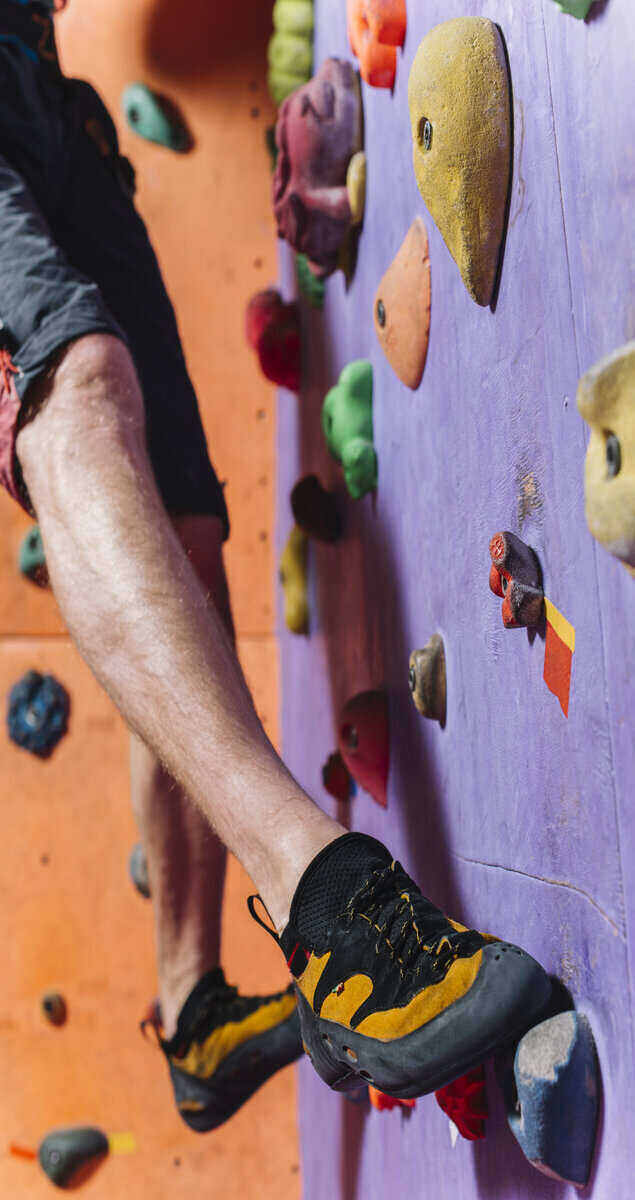Rock climbing is a thrilling journey of skill, strength, and strategy, but the wrong pair of shoes can turn your adventure into a painful misstep.
Whether you’re a beginner tackling your first 5.6 or a seasoned pro sending 5.12+ routes, choosing the right rock climbing shoes is critical to performance, comfort, and safety. In 2025, with advancements in eco-friendly materials and cutting-edge rubber compounds, the options are better than ever—but also more overwhelming. This guide breaks down how to select the perfect climbing shoes based on your skill level, climbing style, and foot shape, with tailored recommendations, expert insights, and a decision-making flowchart to simplify your choice.
Understanding Rock Climbing Shoe Types
Climbing shoes come in three main types: neutral, moderate, and aggressive. Each is designed for specific skill levels and climbing styles, impacting how you interact with the rock.
- Neutral Shoes: These flat-profile shoes prioritize comfort, making them ideal for beginners or long multi-pitch routes. With thicker soles (4–5 mm), they offer durability and support for all-day climbing. Example: La Sportiva Tarantulace ($80) is a top budget pick, praised by 68% of beginner climbers for comfort (REI survey, 2024).
- Moderate Shoes: Featuring a slight downturn, these versatile shoes suit intermediate climbers tackling technical routes. They balance comfort and precision. Example: La Sportiva Katana Lace ($150) excels in edging, per Outdoor Gear Lab’s 2025 tests.
- Aggressive Shoes: With pronounced downturns and thin, sticky rubber (3–3.5 mm), these are built for advanced climbers on steep bouldering or sport routes. Example: Scarpa Instinct VS ($180) is a favorite for bouldering precision.
Why It Matters: A 2024 Climbing Magazine survey found that 72% of advanced climbers prioritize precision over comfort, while beginners lean toward all-day wearability. Choosing the right type ensures your shoes match your goals.
Matching Rock Climbing Shoes to Your Skill Level
Your skill level determines the shoe features you need. Here’s how to choose:
Beginners (5.6–5.10)
New climbers should focus on comfort to build footwork without pain. Neutral shoes with rigid soles support developing technique. According to Treeline Review (2024), 30 beginner-friendly shoes were tested, with the Black Diamond Momentum ($100) topping the list for its plush upper and affordability.
- Recommended Models:
- Black Diamond Momentum: Durable, comfortable, ideal for gym sessions.
- Evolv Defy Black: Budget-friendly ($90) with a forgiving fit.
- Tip: Start with your street shoe size or half a size down to avoid discomfort. A beginner shared on ClimbingShoeReview.com that rentals caused blisters, but the Momentum transformed their gym experience.
Intermediate Climbers (5.10–5.11)
As you tackle technical routes like slabs or overhangs, moderate shoes offer versatility. They provide enough downturn for precision while remaining comfortable for longer climbs.
- Recommended Models:
- Scarpa Vapor V ($160): Great for edging and crack climbing.
- Butora Endeavor: Wide-fit option for diverse routes.
- Real-Life Example: Alisa, a 5.10+ indoor climber, switched to the Scarpa Instinct VS, noting improved confidence on small holds due to its snug fit.
Advanced Climbers (5.12+)
Pros need aggressive shoes for maximum sensitivity on steep or tiny holds. Thin soles and sticky rubber (e.g., Vibram XS Grip2) enhance grip. Pro climber Paige Claassen recommends aggressive shoes for overhanging routes, per Climbing Magazine (2024).
- Recommended Models:
- La Sportiva Solution ($185): Ideal for bouldering precision.
- Tenaya Mastia: Wide-fit aggressive shoe for technical routes.
- Insight: A 2025 Outdoor Gear Lab test found the Solution outperformed competitors in steep terrain due to its soft, sensitive sole.
Key Factors in Choosing Climbing Shoes
Selecting the right shoes involves more than skill level. Consider these factors:
Fit and Sizing
A snug fit without dead space is crucial, but avoid excessive pain. Leather shoes stretch up to a full size, while synthetic shoes maintain their shape. REI (2024) advises shopping in the afternoon when feet are slightly swollen for accuracy.
- Sizing Tips:
- Beginners: Street size or half size down.
- Advanced: 1–1.5 sizes down for performance.
- Try before buying: Visit a climbing gym for demos.
Foot Shape
Foot morphology impacts fit. Brands like Butora and Tenaya cater to wide feet, while La Sportiva offers narrow options.
- Wide Feet: Butora Endeavor, Tenaya Mastia.
- Narrow Feet: La Sportiva Futura, Katana.
- Egyptian Toe: Evolv Shaman LV ($165) molds to pointed toes.
Closure Systems
The closure affects fit and convenience:
- Lace-up: Customizable, ideal for trad climbing (e.g., La Sportiva TC Pro).
- Velcro: Quick adjustments for bouldering (e.g., Scarpa Drago LV).
- Slippers: Lightweight, sensitive, but less secure (e.g., Evolv Rave).
Rubber and Sole Thickness
Rubber type and sole thickness impact performance:
- Vibram XS Edge: Stiff, durable for edging (beginners).
- Vibram XS Grip2: Soft, sticky for smearing (pros).
- Stealth C4: All-around grip, found in Black Diamond shoes.
- Sole Thickness: 4–5 mm for durability; 3–3.5 mm for sensitivity.
Statistic: Outdoor Gear Lab (2025) found that 80% of climbers preferred XS Grip2 for bouldering due to its superior friction on sandstone.
Climbing Style and Terrain
Your climbing style and environment dictate shoe choice:
- Bouldering: Soft, aggressive shoes like Scarpa Drago LV ($190) for small holds.
- Sport Climbing: Moderate shoes like La Sportiva Skwama ($170) for edging and overhangs.
- Trad Climbing: Neutral, high-top shoes like La Sportiva TC Pro ($190) for crack protection.
- Gym Climbing: All-around shoes like Black Diamond Momentum for versatility.
- Terrain:
- Granite: Stiffer soles for cracks (e.g., TC Pro).
- Sandstone: Softer soles for smearing (e.g., Skwama).
Case Study: A trad climber on GearJunkie (2025) reported the TC Pro’s ankle support prevented scrapes in granite cracks, unlike low-top shoes.
2025 Trends in Climbing Shoes
The climbing shoe market in 2025 reflects innovation and sustainability:
- Eco-Friendly Materials: Evolv Rave uses 95% recycled uppers, appealing to 65% of climbers prioritizing sustainability (REI, 2024).
- Improved Rubber: Vibram XS Grip2 and Stealth C4 offer unmatched grip, per Outdoor Gear Lab’s 2025 tests.
- Wide-Fit Options: Butora and Tenaya expand offerings for diverse foot shapes, addressing a common pain point.
Insight: Switchback Travel (2024) notes that eco-conscious shoes are gaining traction, with brands like Evolv leading the charge.
Decision-Making Flowchart
Simplify your choice with this flowchart:
- Skill Level:
- Beginner → Neutral (Tarantulace, Momentum).
- Intermediate → Moderate (Vapor V, Katana).
- Advanced → Aggressive (Solution, Instinct VS).
- Climbing Style:
- Bouldering → Soft, downturned.
- Sport → Moderate/aggressive.
- Trad → Neutral, high-top.
- Foot Shape:
- Wide → Butora, Tenaya.
- Narrow → La Sportiva.
- Budget:
- Under $100: Tarantulace, Defy.
- $150+: Solution, Instinct VS.
SEO Keyword: Climbing shoe guide
Tips for Durability and Maintenance
Maximize your investment with proper care:
- Breaking In: Wear with socks for the first sessions or soak leather shoes in warm water for 10 minutes.
- Resoling: Extend lifespan for $40–60 at local cobblers.
- Cleaning: Brush off dirt and avoid heat to preserve rubber.
Statistic: Resoling can extend shoe life by 50%, per ClimbingShoeReview.com (2023).
Common Mistakes to Avoid
Steer clear of these pitfalls:
- Sizing Too Tight: Causes blisters and reduces performance.
- Ignoring Foot Shape: Leads to discomfort and poor grip.
- Brand Loyalty: Fit trumps brand; try multiple options.
Real-Life Example: A climber on Reddit regretted sizing down two sizes in La Sportiva shoes, causing pain that hindered their 5.11 progress.
You may also interested to know rock climbing gears.
Conclusion
Choosing the right rock climbing shoes transforms your climbing experience, whether you’re a beginner mastering footwork or a pro tackling overhangs. Match your skill level, climbing style, and foot shape to the perfect pair, using our flowchart and 2025 recommendations like the La Sportiva Tarantulace for beginners or Scarpa Instinct VS for advanced boulderers. With eco-friendly trends and advanced rubbers, there’s a shoe for every climber. Visit your local gym to try before you buy, and share your experiences on X with #ClimbingGear to join the conversation!
What’s your go-to climbing shoe? Comment below or tweet us your tips to help fellow climbers find their perfect fit!

